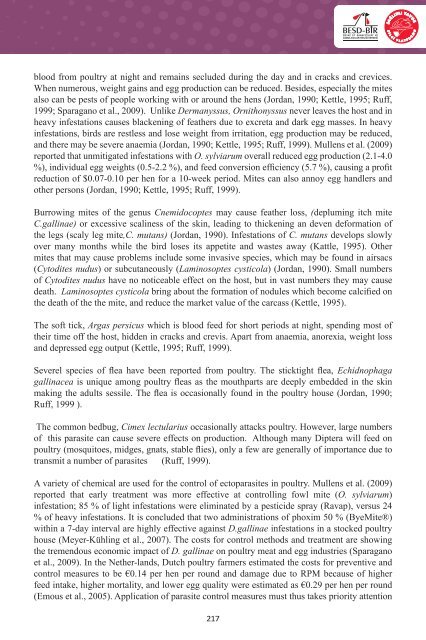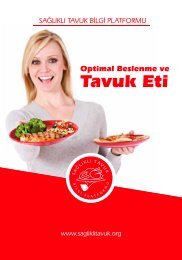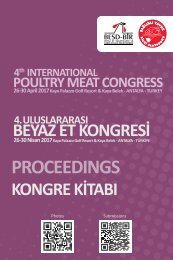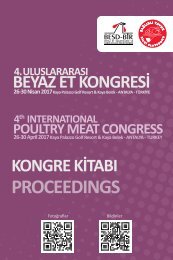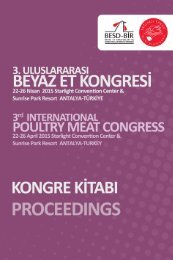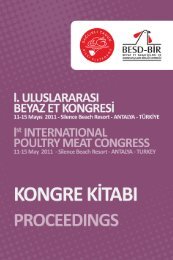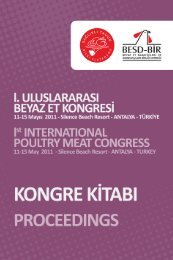3rd International Poultry Meat Congress
Proceedings
Proceedings
Create successful ePaper yourself
Turn your PDF publications into a flip-book with our unique Google optimized e-Paper software.
lood from poultry at night and remains secluded during the day and in cracks and crevices.<br />
When numerous, weight gains and egg production can be reduced. Besides, especially the mites<br />
also can be pests of people working with or around the hens (Jordan, 1990; Kettle, 1995; Ruff,<br />
1999; Sparagano et al., 2009). Unlike Dermanyssus, Ornithonyssus never leaves the host and in<br />
heavy infestations causes blackening of feathers due to excreta and dark egg masses. In heavy<br />
infestations, birds are restless and lose weight from irritation, egg production may be reduced,<br />
and there may be severe anaemia (Jordan, 1990; Kettle, 1995; Ruff, 1999). Mullens et al. (2009)<br />
reported that unmitigated infestations with O. sylviarum overall reduced egg production (2.1-4.0<br />
%), individual egg weights (0.5-2.2 %), and feed conversion efficiency (5.7 %), causing a profit<br />
reduction of $0.07-0.10 per hen for a 10-week period. Mites can also annoy egg handlers and<br />
other persons (Jordan, 1990; Kettle, 1995; Ruff, 1999).<br />
Burrowing mites of the genus Cnemidocoptes may cause feather loss, (depluming itch mite<br />
C.gallinae) or excessive scaliness of the skin, leading to thickening an deven deformation of<br />
the legs (scaly leg mite,C. mutans) (Jordan, 1990). Infestations of C. mutans develops slowly<br />
over many months while the bird loses its appetite and wastes away (Kattle, 1995). Other<br />
mites that may cause problems include some invasive species, which may be found in airsacs<br />
(Cytodites nudus) or subcutaneously (Laminosoptes cysticola) (Jordan, 1990). Small numbers<br />
of Cytodites nudus have no noticeable effect on the host, but in vast numbers they may cause<br />
death. Laminosoptes cysticola bring about the formation of nodules which become calcified on<br />
the death of the the mite, and reduce the market value of the carcass (Kettle, 1995).<br />
The soft tick, Argas persicus which is blood feed for short periods at night, spending most of<br />
their time off the host, hidden in cracks and crevis. Apart from anaemia, anorexia, weight loss<br />
and depressed egg output (Kettle, 1995; Ruff, 1999).<br />
Severel species of flea have been reported from poultry. The sticktight flea, Echidnophaga<br />
gallinacea is unique among poultry fleas as the mouthparts are deeply embedded in the skin<br />
making the adults sessile. The flea is occasionally found in the poultry house (Jordan, 1990;<br />
Ruff, 1999 ).<br />
The common bedbug, Cimex lectularius occasionally attacks poultry. However, large numbers<br />
of this parasite can cause severe effects on production. Although many Diptera will feed on<br />
poultry (mosquitoes, midges, gnats, stable flies), only a few are generally of importance due to<br />
transmit a number of parasites (Ruff, 1999).<br />
A variety of chemical are used for the control of ectoparasites in poultry. Mullens et al. (2009)<br />
reported that early treatment was more effective at controlling fowl mite (O. sylviarum)<br />
infestation; 85 % of light infestations were eliminated by a pesticide spray (Ravap), versus 24<br />
% of heavy infestations. It is concluded that two administrations of phoxim 50 % (ByeMite®)<br />
within a 7-day interval are highly effective against D.gallinae infestations in a stocked poultry<br />
house (Meyer-Kühling et al., 2007). The costs for control methods and treatment are showing<br />
the tremendous economic impact of D. gallinae on poultry meat and egg industries (Sparagano<br />
et al., 2009). In the Nether-lands, Dutch poultry farmers estimated the costs for preventive and<br />
control measures to be €0.14 per hen per round and damage due to RPM because of higher<br />
feed intake, higher mortality, and lower egg quality were estimated as €0.29 per hen per round<br />
(Emous et al., 2005). Application of parasite control measures must thus takes priority attention<br />
217


